User Manual
Fix Phaser
Intro
Overview
User Interface
Tweaking Tips
Fix Phaser for Modular and Amp Room
Extended Features
Credits
The Phaser was originally invented by a sound engineer in the mid 1960s while trying electronically emulate the effect of a rotating Leslie-cabinet. Although similar effects had already been produced by others with experimental equipment earlier, the first commercial product to feature the phasing effect did not surface until the late 60s.
A phaser effect is created by splitting input audio into two different paths and then mixing them together. One path treats the signal with all-pass filters, which preserves the amplitude of the original signal but alters the phase. The amount of phase change is frequency dependent. When this phase-altered signal is mixed together with the other path, the dry signal, the frequencies that are out of phase will cancel each other out which creates the characteristic audio phase-notches. By changing the dry/wet mix the depth of these notches are altered. The deepest notches occur when the dry/wet mix ratio is 50% (this is the preset value in Fix Phaser).
The Difference between Flanger and Phaser
Historically, there has always been much confusion about what is phasing and what is flanging: The difference between phasing and flanging is that the latter creates an unlimited series of equally spaced notches and peaks, where phaser creates a limited number of notches with uneven spacing. This means that flanging is very much a similar sounding effect to phaser, but in the Flanger, the notches are linearly spaced in the frequency domain. Flanger is typically created by mixing a delayed version with itself and often tend to sound more pronounced and natural (“jetplane”), whereas phaser often sound more electronic and otherworldly (“space-whosh”).
The Fix Phaser is a very versatile effect with the ability to re-create everything from the phasing sounds of various classic gear to the more vintage sounding vibratos derived from the late 60s. Like the other Softube Fix products it has a dry/wet Mix knob giving the user the freedom to freely set their desired blend of dry input and the fully wet signal.
The Fix Phaser features three main phasing modes – Normal, Effect and Wide. Normal mode is the classic phase-shifting sound with all the liquid transparency, whooshing sweeps and tingling swirls we're all used to. Effect mode adds a pronounced chasing stereo effect where the left channel's sweep is out of phase with the right channel's sweep, and Wide mode further expands on this principle where a subtle widening effect is still apparent even when using small sweep amount.
The Fix Phaser is swept up and down by a sweep-generator with variable amount, rate and sweep type.
Finally, the Fix Phaser also feature an envelope-follower with fast and slow mode, positive and negative response, that makes it possible to use create auto-wah style effects among other things.
The Fix Phaser panel contains the following twelve simple and easy to use controls. This is a brief description of each and everyone:
Engage (Out/In): This button turns effect on and off. Effect is bypassed when Engage is set to “out”.
DAW Sync (Sweep/Sync): This locks the rate of the Sweep generator to the tempo of your DAW when set to “Sync” (DAW sync lamp is lit).
Stereo (Normal/Effect/Wide):
Normal: This is classic phaser mode where both sides of the stereo input is treated equally.
Effect: Enhances the stereo effect of the phaser by using the same phase-shift on left and right side but with different phase on the sweep. This gives the phaser more of a “chaser”-kind of effect where one side always is chasing the other.
Wide: Left and right phase will change in amplitude and polarity in a preset ratio to the sweep in addition to the effect mode. Wide mode makes the soundstage wider and creates a subtle, musical movement which is very handy when mixing static program material.
Note: When using Phaser with Stereo mode set to Wide, the sweep modulation will always affect some aspects of the phasing with a preset value which is not affected by the Sweep (amount) knob This is by design and intentional behaviour.
Stages (2,4,6,8,10): These buttons set the amount of phaser stages used. Two stages creates one notch, 4 stages creates two phasernotches etc. This is one of the key elements to look at when re-creating the phaser sound of classic gear.
Sweep Type (Triangle/Sine/Elliptic): Selects the type of waveform used for the sweep:
TRIANGLE-waveform: Suitable for creating a regular, ongoing phaser movement.
SINE-waveform: Can be used for more natural sounding phaser movement.
ELLIPTIC-waveform: This sweep type spends more time on high frequencies than lower ones.
Slow (Fast/Slow): This switch determines how swift the envelope follower will react to an incoming signal. Use Fast response for drums, rhythmic guitar or clavinet picking, and Slow response for sustained chords and synth-pads.
Mix (Dry/Wet): This knob set the mix between dry (uneffected) input signal and the fully wet signal. When set to fully wet the Fix Phaser can be used as a vibrato-like effect, bending input notes up and down in sync with the sweep rate.
Regen (0-100%): Sets the amount of feedback for the end of all pass chain. A large amount of Regen make the Fix Phaser sound more electronic and out of this world.
Envelope (-100% - 0 - 100%): This is the amount of which the envelope follower will affect the modal center movement. It is a polarized knob which means that the counter-clockwise position at -100% means that it will have a negative sweep impact on the phaser movement. AWith the knob at 12 o'clock it has no effect (default value), and at fully clockwise, it will have full positive effect on the phaser movement.
Phase offset (20hz - 20kHz): Sets the offset of the phased signal.
Sweep (0-100%): This knob sets the Sweep amount to affect the phaser movement back and forth.
Rate (0.01hz - 6hz): Sets the speed of the Sweep, ranging from 0.01 to 6 hz. This means that, when Rate is set to lowest the lowest speed, 0.01 hz, it will take 100 seconds for the sweep generator to complete its cycle, while at the highest rate completion will occur 6 times per second.
When DAW sync is set to “Sync”, Rate is divided into 8 bars, 6 bars, 4, 3, 2, 1.5, 1 bar, half bar, dotted quarter, quarter and eighths parts of a bar. These values represent how many time-measures it takes for a sweep cycle to complete.
Meters
Modal Centers: This meter on the upper part of the plugin shows how many phase notches that are active and approximately on which frequency they are currently at work. More stages selected by the stage buttons means more notches. The modal center display is also a handy tool in order to understand the envelope sweep and polarity, phase offset and sweep rate and range.
Level: This meter reflects output level. Keep this meter in the green or yellow for optimum response. Lower input volume or Regen if this meter is in the red.
Sweep: This meter shows the movement of the sweep generator at all times and is not affected by the Sweep (amount) knob.
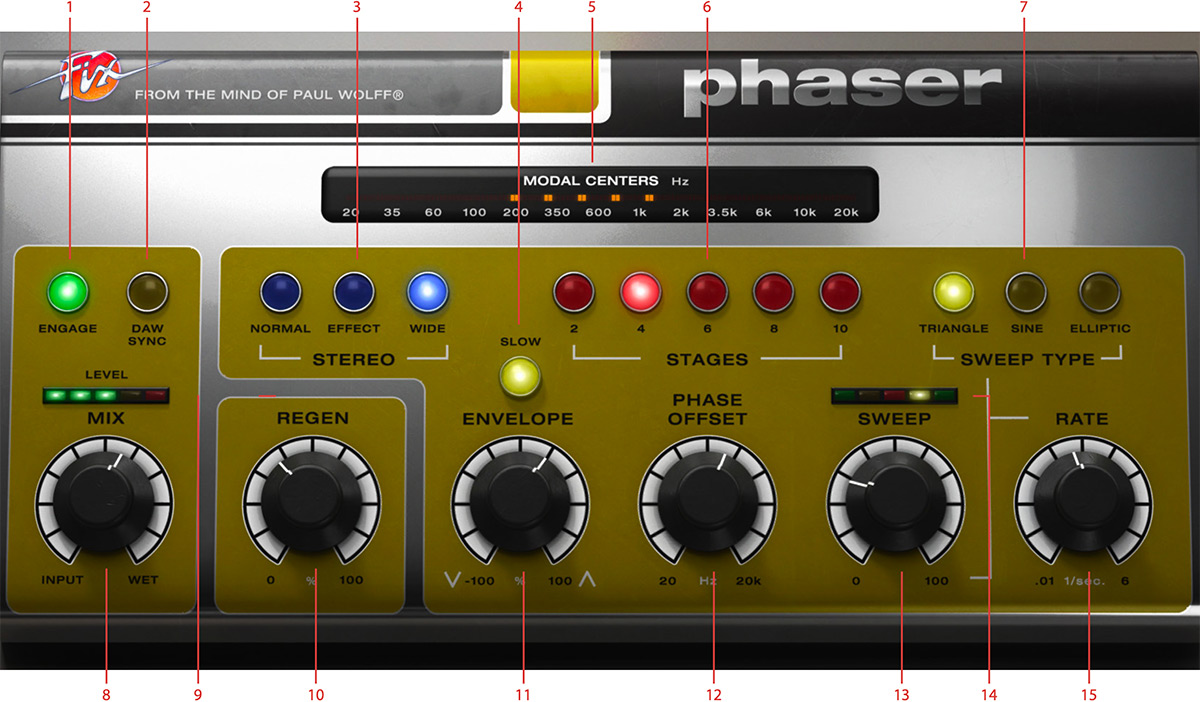
-
Engage
-
Daw Sync
-
Stereo (Normal/Effect/Wide)
-
Slow
-
Modal centers
-
Stages (2,4,6,8,10)
-
Sweep type (Triangle/Sine/Eliptic)
-
Mix
-
Level meter
-
Regen
-
Envelope
-
Phase offset
-
Sweep
-
Sweep meter
-
Rate
Here's a few pointers to guide you when using the Fix Phaser:
Mix ratio is essential for getting the most effective phase-cancellation - the preset value 50% is will give you the deepest phase-cancellation If the mix ratio is raised towards 100% wet, the phase-effect will get more “pitchy”, especially with many stages selected.
This “pitchy” effect can be used to create vibrato effects with the Fix Phaser Set Mix ratio to 100%, use 6 or more stages and a fairly high (30% +) sweep and you’ll start hearing pitching effects.
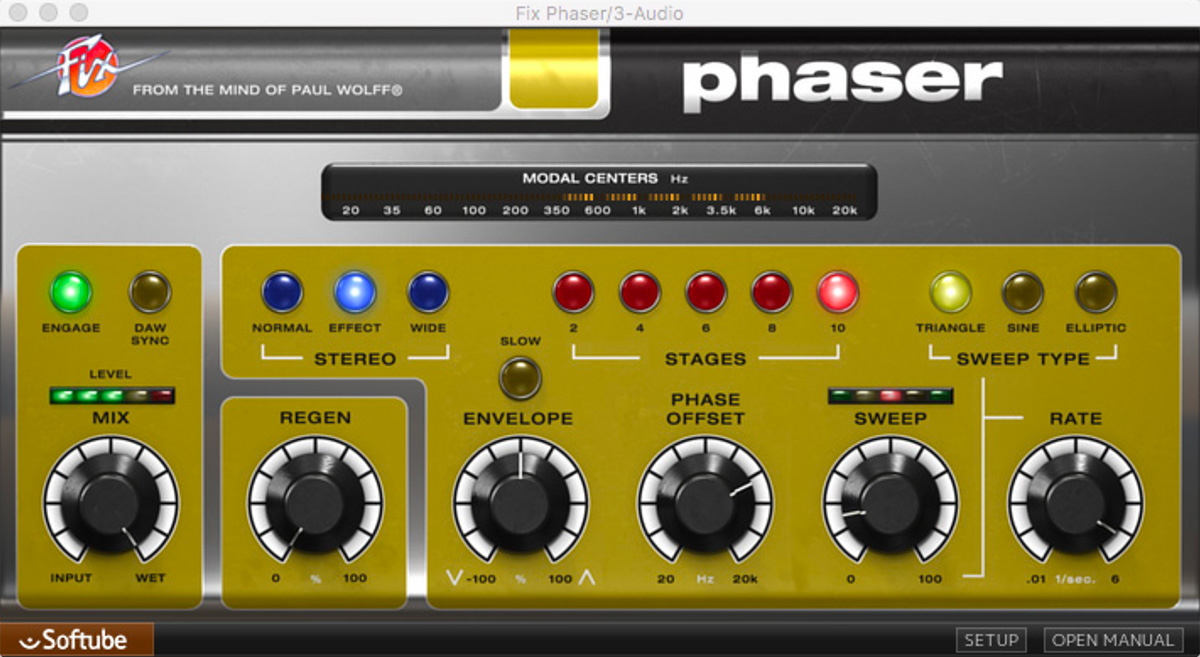
By using extreme mix settings (100% wet) in combination with the Stereo “Wide” mode, tremolo, as well as combined “tremolo + vibrato” effects can be achieved in the same way.

Click here to view the full-sized image in a new tab
The number of stages selected will greatly affect your phaser sound Try for example a slowly sweeping phaser using 2 or 4 stages with high Regen Now, try instead 10 stages and listen to the difference The more stages, the more “hollow” and “electric” phaser characteristics.

Click here to view the full-sized image in a new tab
You can also use the Phaser with a low dry/wet ratio (25-30%), low sweep (30%) with a fairly swift sweep rate (3 hz), and no regen in order to create a “Chorus”-like effect.
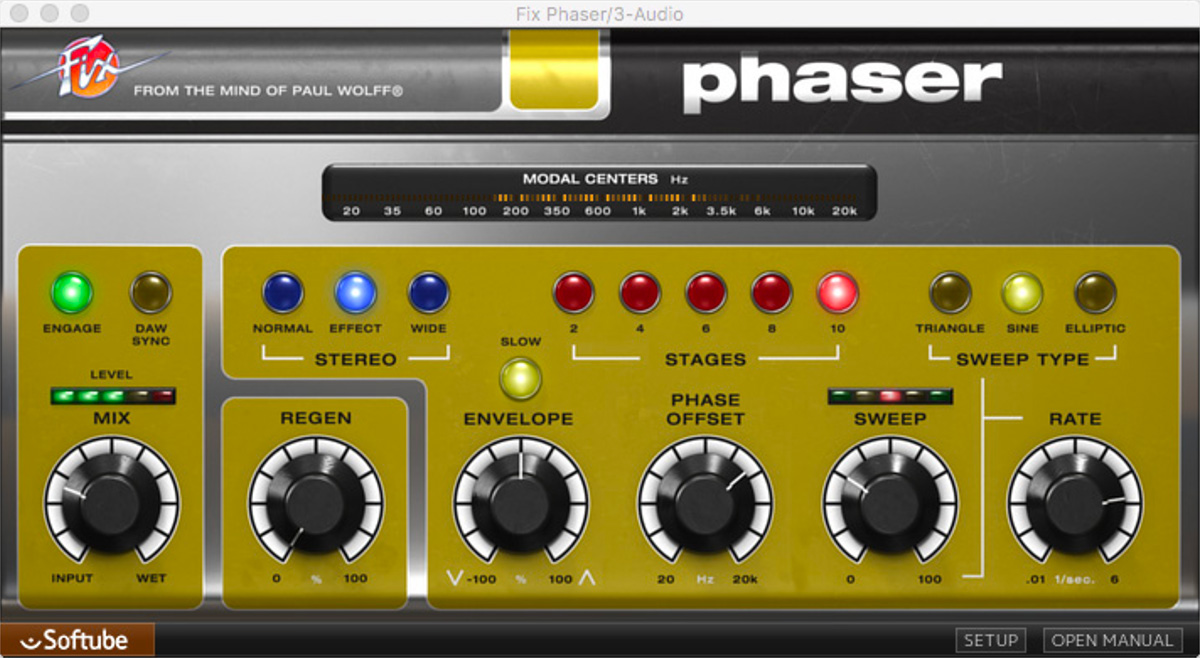
The envelope-follower feature of the Fix Phaser is great for creating auto-wah like phasing Use the Fast mode for staccato, funky fast playing or drums, and use the Slow Mode for sustained chords, strings and pads.
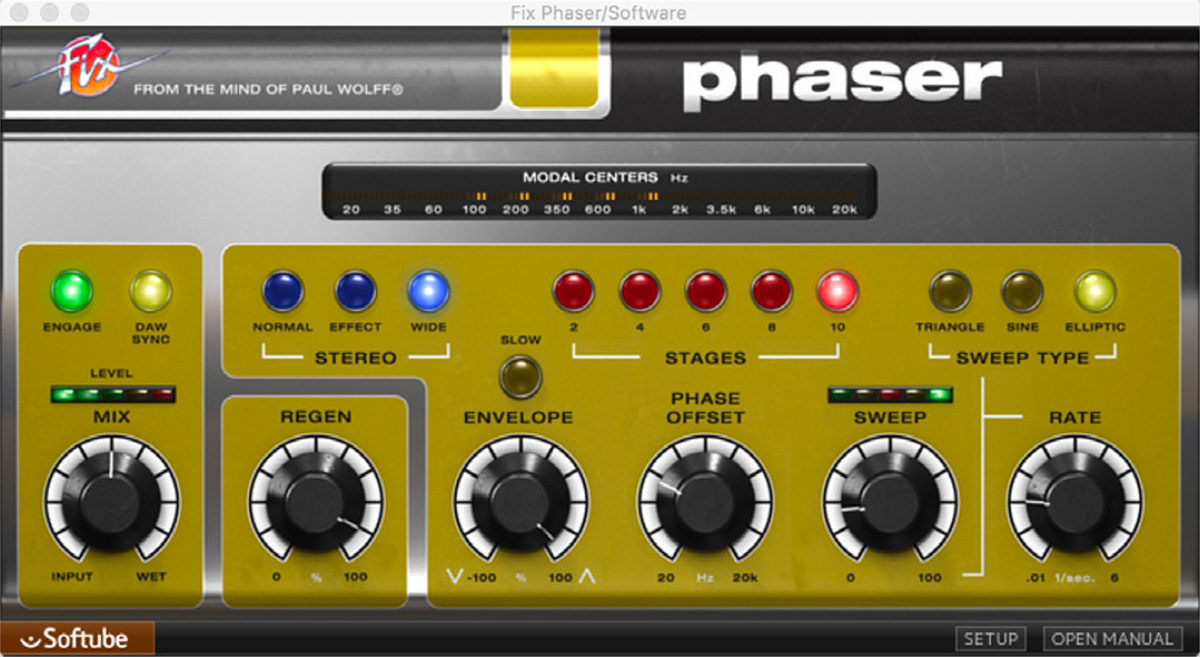
Finally, the Fix Phaser can also be used as a subtle or not so subtle stereo widener in the Stereo “Wide” mode Using the Phaser with 60-70% wet mix, many stages selected and Sweep set at minimum (0%), the Regen and Offset knobs can be used to set the focus and “hollowness” of the stereo movement The speed of this movement is set by the Sweep Rate knob.
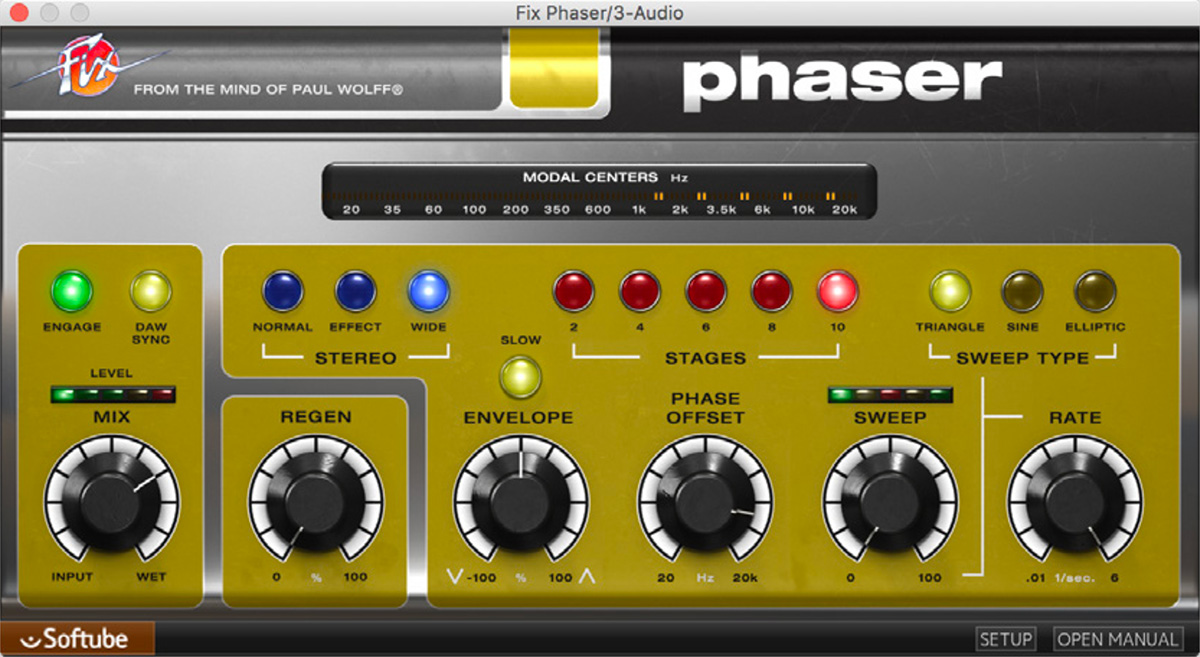
Fix Phaser for Modular and Amp Room
Fix Phaser can also be used as module in Modular and as effect in Amp Room.
The algorithm is the same, but the interface is focused on the most relevant features for an easy and quick access.
The use in Modular allows for automatic voltage control of some of the parameters.
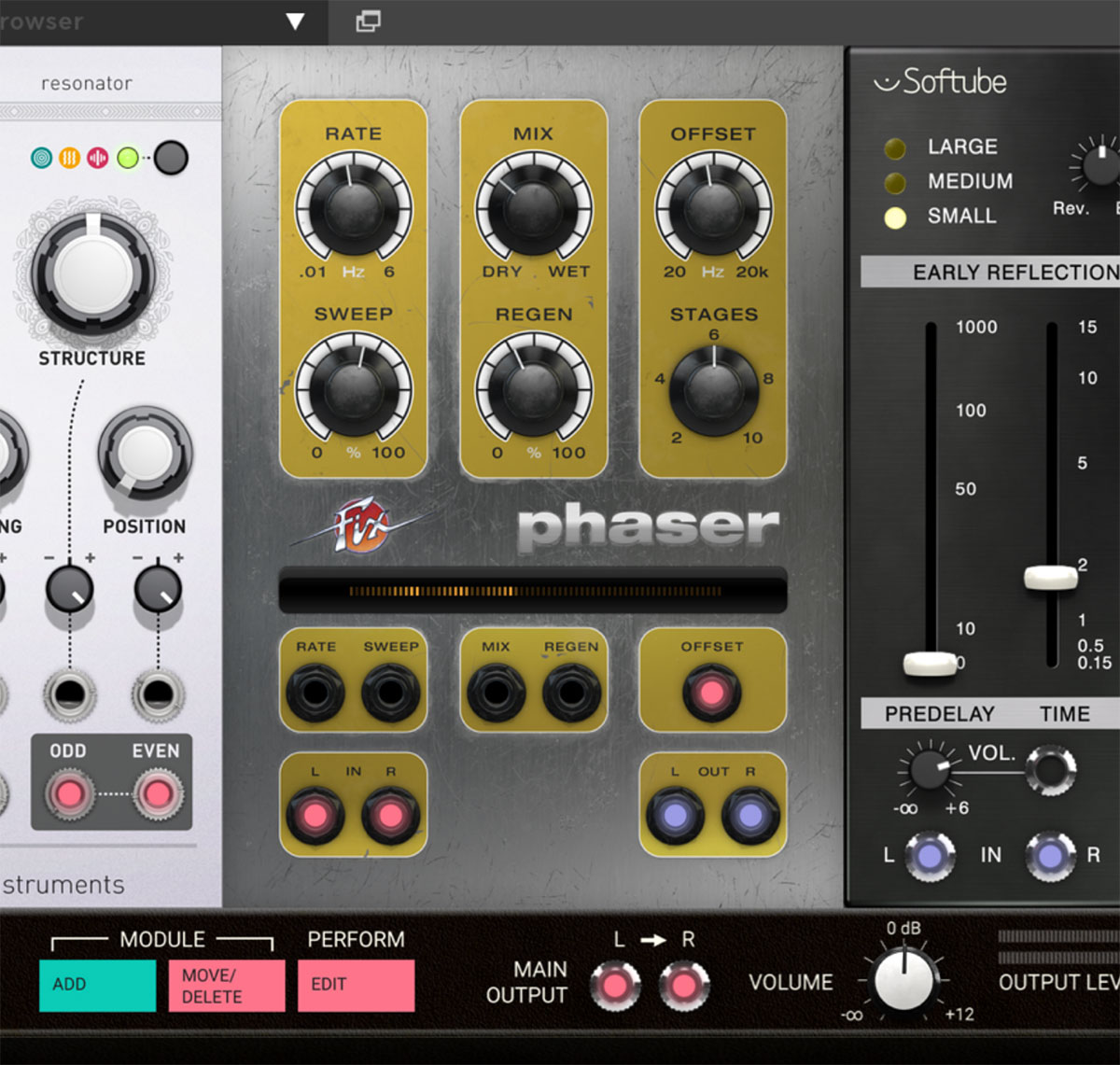
Fix Phaser for Modular
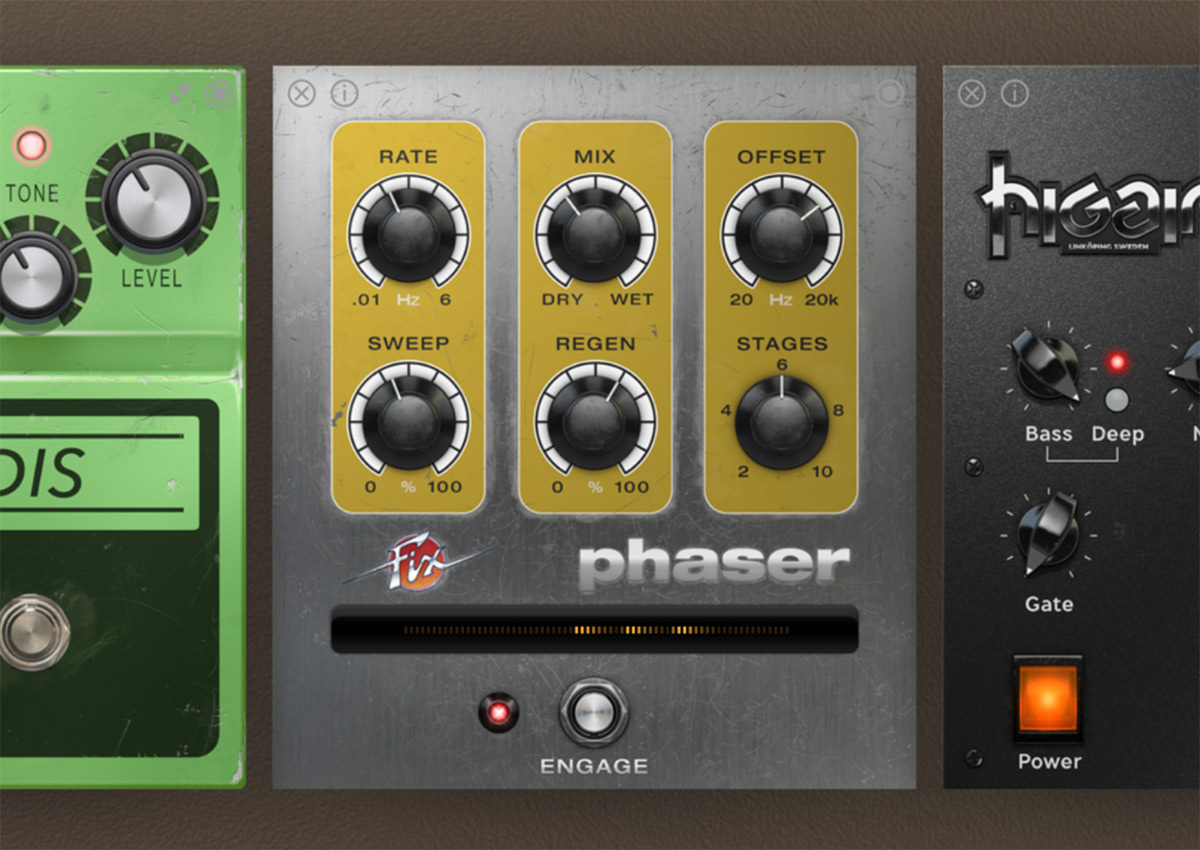
Fix Phaser for Amp Room
Here a brief description of the features of the module and effect:
Parameters
Rate: Sets the speed of the sweep, ranging from 0.01 Hz to 6 Hz.
Sweep: Sets the sweep amount to affect the phaser movement back and forth.
Mix: Sets the balance between dry and wet signal.
Regen: Sets the amount of feedback for the end of the all-pass chain.
Offset: Sets the offset of the phased signal.
Stages: Sets the amount of phaser stages used.
In addition, the module has:
Inputs
Left input: Input for left channel.
Right input: Input for right channel.
Rate: CV Input for the Rate parameter.
Sweep: CV Input for the Sweep parameter.
Mix: CV Input for the Mix parameter.
Regen: CV Input for the Regen parameter.
Offset: CV Input for the Phase Offset parameter.
Outputs
Left output: Output for left channel.
Right output: Output for right channel.
A whole range of added control can be accessed with Extended Features. Please see the separate "Extended Features" manual for more information.
Paul Wolff – Idea, testing and feedback
Arvid Rosén – Model analysis and implementation
Paul Shyrinskykh– Algorithms testing and feedback
Niklas Odelholm – Programming and GUI
Kristofer Ulfves – User manual and testing
Joe Chiccarelli – Presets and testing
Ulf Ekelöf – 3D rendering and graphics